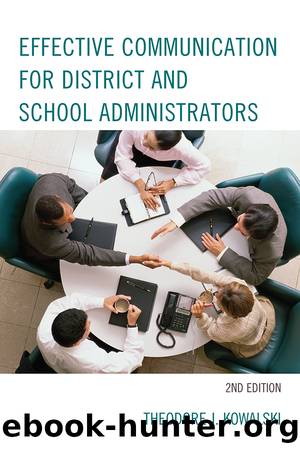Effective Communication for District and School Administrators by Kowalski Theodore J.;

Author:Kowalski, Theodore J.; [Kowalski, Theodore J.]
Language: eng
Format: epub
Publisher: Rowman & Littlefield Publishers
Published: 2015-08-15T00:00:00+00:00
These difficulties are explored in detail later in this chapter.
Closed and Open Climates
The most common descriptor of school climate pertains to orientations toward internal associations and associations with the external environment (i.e., the ecosystem in which the school exists). The extremes are a closed climate and an open climate. Differences between the two are exemplified by the disparate behavior of two boards of education in neighboring districts. The first board meets once a month on a Saturday at 8:00 a.m. in the superintendentâs conference room, a small area not large enough to provide seating for visitors. Only on rare occasions are visitors, including district employees, allowed to speak at these meetings. Typically, the meetings are over by 9:15 a.m., and then board members and the superintendent go to a local diner for breakfast.
The second school board meets at least twice a month on Tuesday evenings at 7:00 p.m. The location is purposefully rotated, allowing each of the districtâs five schools to host a minimum of three board meetings per year. Refreshments are provided, and visitors are allowed to ask questions, make comments, or suggest improvements.
Conditions in the first district, such as an inconvenient meeting time, an inadequate location, and a minimum number of meetings per year, are indicative of a closed climate. Conditions in the second district, such as a convenient meeting time, a rotated location, refreshments, and interactive discussions, are indicative of an open climate.
In the past, school officials often tried to preserve a closed climate because of negative views toward conflict. More recently, astute administrators recognized that restricting legal, social, political, and economic influence is not prudent. Constraining citizen involvement is undemocratic, and eliminating external interventions in an information-based society is basically unachievable (Kowalski, 2013). Stakeholders in most districts want administrators to lead, but they insist on being included in open and fair debates about ideas and administrative recommendations (Baker, 1997).
Schools rarely are completely closed or open climates; instead, their climates are skewed toward one pole or the other. In a closed climate, employees are disengaged, suspicious, and isolated, the principal is directive, remote, and nonsupportive, and external interventions are resisted as a probable source of conflict (Hanson, 2003). For instance, administrators committed to a closed climate believe that employees drawn into disagreements either internally with coworkers or externally with parents, government agencies, or special interest groups spend less time performing their assigned duties. As such, conflict reduces technical efficiency (Hanson, 2003). In an open climate, collegiality, interaction, and external interventions are not only tolerated, they are also encouraged, primarily because conflict is viewed in a positive light. For example, administrators committed to an open climate treat conflict as a catalyst for needed change. Explaining this disposition, Uline, Tschannen-Moran, and Perez (2003) wrote:
Conflict is a natural part of collective human experience. In our efforts to cooperate with one another, we have differences of opinion about how best to accomplish our common goals. We seek to protect our individual interests within these efforts and forestall outside influences, fearing discord in the face of these conflicting forces.
Download
This site does not store any files on its server. We only index and link to content provided by other sites. Please contact the content providers to delete copyright contents if any and email us, we'll remove relevant links or contents immediately.
Chicken Soup for the Soul Presents Teens Talkin' Faith by Jack Canfield(697)
Understanding PDA Autism in Kids: A Guide for Parents and Teachers to Support Neurodiverse Learners by Jehu Len(561)
The Victorian Era: A Captivating Guide to the Life of Queen Victoria and an Era in the History of the United Kingdom Known for Its Hierarchy-Based Social Order by Captivating History(429)
Brain Teasers to Build Critical Thinking Skills: Brain Exercises for Tech, Banking, Case Interview Prep, and to Keep Your Mind Sharp by Kris Safarova(416)
Brain Teasers to Build Critical Thinking Skills by Safarova Kris(414)
100 Ideas for Secondary Teachers: Engaging Parents by Janet Goodall & Kathryn Weston(391)
Python 101 - Fundamentals by Sam(376)
Critical Curriculum Leadership : A Framework for Progressive Education by Rose M. Ylimaki(366)
Writing Solid Code: Development Philosophies for Writing Bug-Free Programs by Steve Maguire(360)
The Art of Emotional Validation: Improve Your Communication Skills and Transform Your Relationships by Validating Emotions and Feelings by Emily Wright(340)
Intersectionality in Educational Research by Dannielle Joy Davis; James L. Olive; Rachelle J. Brunn-Bevel; Susan R. Jones(337)
The Knights Templar: An Enthralling History of the Rise and Fall of the Most Influential Catholic Military Order by Wellman Billy(331)
A Beginner's Guide to SSD Firmware by Unknown(330)
The Future Knowledge Compendium by Ellyard Peter;(320)
How to be assertive in any situation by Hadfield Sue & Hasson Gill(312)
Making Connections in and Through Arts-Based Educational Research by Hala Mreiwed Mindy R. Carter Sara Hashem Candace H. Blake-Amarante(309)
Foundations of Educational Research by Victoria Elliott(309)
What Every Teacher Should Know about Learning, Memory, and the Brain by Tileston Donna E. Walker;(307)
Message from the Pleiades; The Contact Notes of Eduard Billy Meier v1 only by unknow(303)
